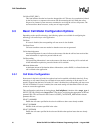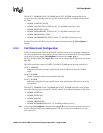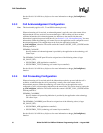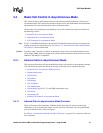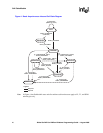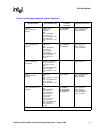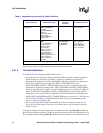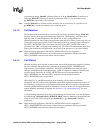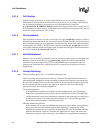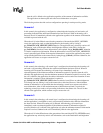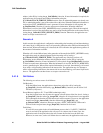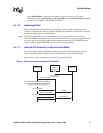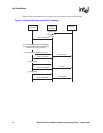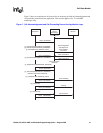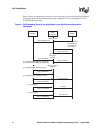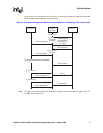
44 Global Call API for HMP on Windows Programming Guide — August 2006
Call State Models
3.4.1.5 Call Routing
After the call has been offered, a call proceeding indication can be sent to the remote party to
indicate that all the information has been received and the call is now proceeding. This indication
can be sent by the technology call control layer or by the application by issuing the
gc_CallAck(GCACK_SERVICE_PROC) function. This stage typically involves routing the call
to the destination exchange or party. An information call routing tone can be played at this point to
inform the remote party that the call is routing.
3.4.1.6 Call Acceptance
If the application or thread is not ready to answer the call, a gc_AcceptCall( ) function is issued to
indicate to the remote end that the call was received but not yet answered. This provides an interval
during which the system can verify parameters, determine routing, and perform other tasks before
connecting the call. A GCEV_ACCEPT event is generated when the gc_AcceptCall( ) function is
successfully completed and the call changes to the Accepted state. The application can then answer
the call by issuing the gc_AnswerCall( ) function.
3.4.1.7 Call Establishment
When the call is to be directly connected, such as to a voice messaging system, or if the application
or thread is ready to answer the call, a gc_AnswerCall( ) function is issued to make the final
connection. Upon answering the call, a GCEV_ANSWERED event is generated and the call
changes to the Connected state. At this point, the call is connected to the called party and call
charges begin.
3.4.1.8 Overlap Receiving
Note: This functionality applies to E1, T1 and ISDN technologies only.
After an incoming call has been received, the call is offered to the application based on the call
acknowledgement configuration and the availability of information required for proceeding with
the call. If the incoming call is in en-bloc mode where all the information required for processing
the call is present, the call is offered to the application. Otherwise, the call is offered to the
application based on the following configurations:
Call Acknowledgement
If the application is configured to send the call acknowledgement, the call is immediately
offered to the application regardless of the amount of information available. The application
can then request and collect more information as required. If the technology call control layer
is configured to send the call acknowledgement, then the call is offered to the application
based on the minimum amount of information specified.
Minimum Information Specified
If the incoming call does not have sufficient information, the call is offered to the application
based on the amount of information required. If the technology is configured to accept
minimum information, the call is offered to the application only after the specified minimum
amount of information is received. Thereafter, the application can request and collect more
information as required. If the technology is not configured to accept minimum information,



